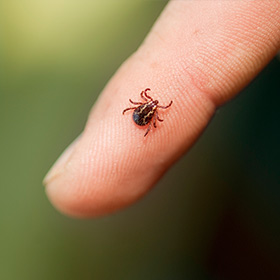- Community & News
- Conditions & Care
- Orthopedics
- Patient Stories
- Service Line
- Treatments
Lyme Disease: What You Need to Know

Tick season is looming, which means outdoorsy folks will soon be on high-alert for the most common tick-borne illness in the United States: Lyme disease.
While reports of Lyme disease are less common in Ohio, if your vacations involve camping or hiking in the Northeastern or North-central states, or along the West Coast, Scott R. Friedstrom MD, of the TriHealth Infectious Diseases group, says it’s smart to take preventive measures.
Lyme Disease: What is It?
Lyme disease is an infection caused by a bacteria-like organism that is spread to people through the bite of one of several types of ticks. It is most commonly spread through the bite of a deer tick.
“Now, the bite alone isn’t necessary,” Dr. Friedstrom explains. “We think the tick has to be attached for more than 24 hours in order to transmit Lyme disease.”
Common Symptoms of Lyme Disease
Lyme disease typically progresses in three stages, depending on how early it is detected and treated.
Stage 1
This condition often reveals itself early on through the appearance of a rash, called erythema migrans (ECM), which appears at the site of the bite. The rash is usually red with a white center (resembling a target) that may develop anywhere from three days to three weeks after the bite. The rash may get bigger or begin showing up in multiple places on the body as it spreads. However, not everyone with stage 1 Lyme disease develops the rash.
This phase may also include flu-like symptoms, including a fever or general fatigue.
Stage 2
In stage two, as the bacteria have begun spreading throughout the body, the infection may start affecting the joints, nervous system, heart and brain.
Heart problems may include skipped heartbeats, chest pain or shortness of breath.
As far as its impact on the central nervous system, symptoms a person infected with stage 2 Lyme disease may experience include numbness or pain in the nerve area, or paralysis or weakness in muscles of the face. “It can cause an illness that you might mistake for multiple sclerosis,” Dr. Friedstrom adds.
Stage 3
Those with phase stage 3 Lyme disease may experience long-term joint inflammation as the bacteria continue to spread. “The form of Lyme disease that people are most worried about is arthritis – or the late manifestation of arthritis,” Dr. Friedstrom points out. However, he says: "It takes months to years to reach stage 3."
Other symptoms that may occur if Lyme disease reaches this stage include:
- Decreased concentration
- Memory disorders
- Nerve damage
- Numbness
- Pain
- Paralysis of the face muscles
- Sleep disorders
- Vision problems
Diagnosing and Treating Lyme Disease
If you know you were bitten by a deer tick, Dr. Friedstrom says to bathe immediately. From there, especially if you develop the rash, you should schedule an appointment with your doctor right away.
Antibiotics
Unfortunately, there is not a test available for diagnosing Lyme disease early on; however, your doctor may prescribe an antibiotic, called doxycycline. "If they get this rash in deer tick season, then they ought to go to their doctor, because if you give doxycycline right away, it's absolutely curable," Dr. Friedstrom points out.
Other common oral antibiotics used to treat early Lyme disease are amoxicillin, azithromycin, cefuroxime, and ceftriaxone. A 10-day to four-week course of antibiotics is prescribed, depending on the particular drug. If treated within 72 hours of exposure, the antibiotics will usually destroy the disease.
Intravenous antibiotics may be administered to treat later stages of the disease.
Testing for Lyme Disease
About a month after the initial infection, blood tests may be administered to check for antibodies to the bacteria that cause Lyme disease. Still, Dr. Friedstrom stresses, "the diagnosis remains controversial and here's the reason: We don't have great blood tests for it and we have to use a blood test to diagnose it ... We have to rely on immune tests – tests that detect antibodies."
These tests do not detect the presence of the disease itself, but test to determine whether the individual's body has developed antibodies to fight the bacteria associated with the disease.
Another issue with blood tests is that they could draw false positive or false negative results, and therefore should not be used to diagnose Lyme disease in individuals who do not have obvious symptoms or other reasons to believe they have been infected with Lyme.
Ways to Prevent Lyme Disease
It’s important to avoid tick-infested areas; but, if you know you are going into an outdoor area where ticks are prevalent, Dr. Friedstrom suggests:
- Applying a tick repellant containing the chemical DEET to all exposed skin and clothing
- Wearing long-sleeved shirts and pants
- Wearing clothes treated with a product containing permethrin (permethrin sprays should not be applied to the skin)
- Showering soon after coming indoors
Related Articles
- Conditions & Care
- Pediatrics
- Primary Care
- Service Line
- Treatments
- Conditions & Care
- Diabetes
- Disease & Symptom Information
- Patient Stories
- Service Line